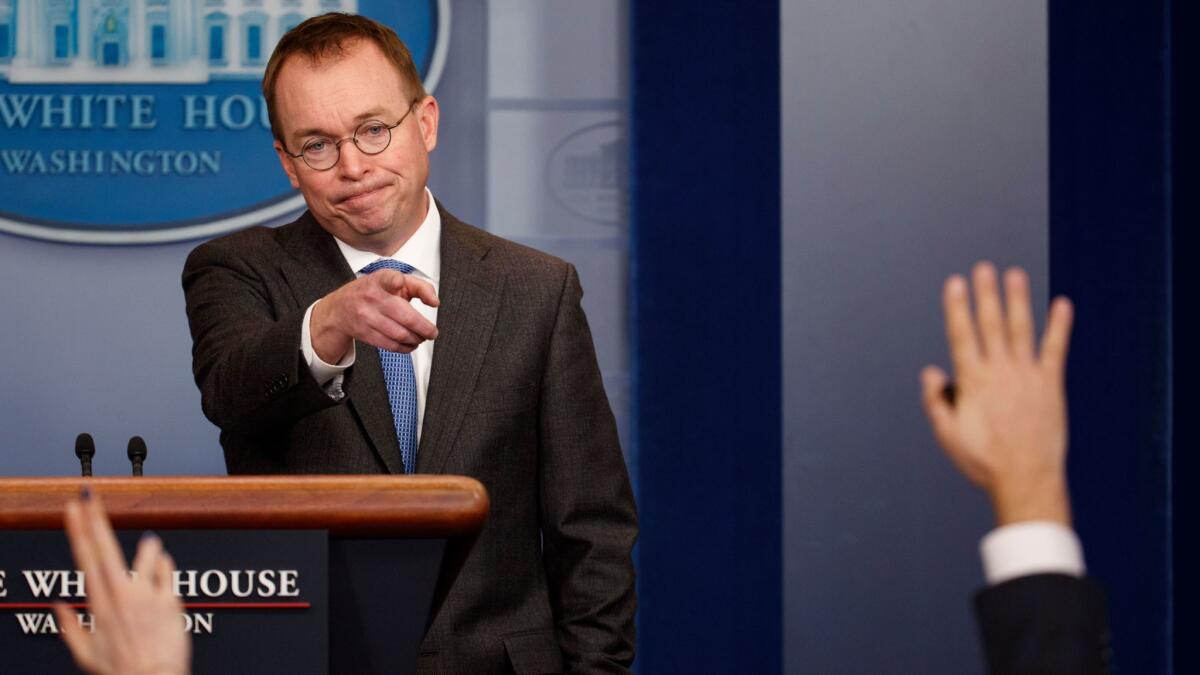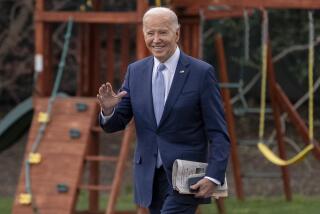White House promises this shutdown ‘will look very different.’ Will it?

The government shutdown is fast becoming an unwelcome and costly staple of American democracy. After the last prolonged closure delivered a substantial hit to the economy and created hardship and frustration for millions, lawmakers vowed never again.
And yet, here we are again.
The Trump administration is scrambling to soften the blow with plans to keep as much of the government open as possible even if Congress fails to pass a measure by Monday morning to fund government agencies. Its blueprints, though, could quickly unravel.
“We are going to manage this shutdown differently,” said Mick Mulvaney, the White House budget director, who accused the previous administration of using the 2013 budget stalemate to score political points, making the repercussions more painful for Americans than necessary.
“We are not going to weaponize it. We are not going to try to hurt people,” he told reporters at the White House.
In a briefing for reporters Friday evening, senior administration officials said they could not cite any specific evidence of the Obama administration having held back federal funds to worsen the impact of previous shutdowns.
“We’re not here to litigate the past,” said one of the officials, who spoke to reporters on condition of anonymity.
The Trump administration was encouraging agencies to use any reserve funds or other available money that legally could keep offices open, if only temporarily, while the Obama administration may have interpreted the law more narrowly, the officials said.
Whatever the White House’s intentions, however, some hurt from a shutdown is unavoidable. The law places the federal government under extremely restrictive constraints.
Some important government functions are not affected — Social Security checks go out regardless because they are not subject to annual appropriations bills that expire. The same goes for most other benefit programs. Military operations continue, although the nation’s roughly 1.3 million uniformed personnel would not get paid until after a shutdown ends.
The senior officials said they did not have a total of how many workers would be furloughed across the government. In most cases, however, agencies have no choice but to send the vast majority of their workforce home. Only those performing critical public health and safety functions remain, and, like the military, they typically do not get paid until it is all over.
Mulvaney’s vow that there would be no mass closure of national parks, for example — just some minor public inconvenience along the lines of “things like trash won’t get picked up” — could quickly get undercut by the realities of how the parks operate.
Some 85% of the employees who keep the parks running would be prohibited from working, according to the administration’s planning documents. Visitors’ centers and bathrooms would be shuttered. Maintenance crews will be sent home. Roads won’t be plowed, and campsites won’t get cleaned.
“Trying to run national parks without park rangers not only creates unnecessary dangers for visiting families, but puts the parks’ natural, cultural and historic resources at risk,” said Kate Kelly, public lands director at the left-leaning Center for American Progress.
The plan to leave gates open while sending maintenance staffs home comes as many of the nation’s parks are already struggling with a surge in visitors that has created land management and crowd control problems even when fully staffed. Under the shutdown blueprint, hordes of visitors might not even be able to find a working toilet.
By Monday, the fallout on the public would intensify. All the museums run by the Smithsonian would have closed, its 715,000 daily visitors turned away. Roughly 850,000 federal workers, including members of the military, would stop collecting paychecks. Agencies would stop delivering public health programs, although the senior administration officials said the Centers for Disease Control and Prevention would continue at least some of its work on flu prevention, reversing previous reports that the work could come to a halt amid one of the worst influenza epidemics in recent years.
The Internal Revenue Service is facing the furlough of more than half its workforce just as its agents — and taxpayers — are grappling with an upended tax code resulting from the wide-ranging changes signed into law late last year. Banks could be forced to delay tens of thousands of loans, as the IRS becomes unable to provide applicant income verification.
Approvals that any number of businesses need from other agencies to move forward with their plans — from oil companies seeking drilling permits to airlines seeking to register new planes — could be frozen.
“Shutting down the government is a very serious thing,” Sen. Dianne Feinstein (D-Calif.) told CNN on Thursday night. “People die, accidents happen. You don’t know. Necessary functions can cease. … There is no specific list you can look at and make a judgment, ‘Well, everything is going to be just fine.’ You can’t make that judgment.”
After the shutdown of 2013, a sobering federal report assessed the damage it inflicted on the nation. The report by the Office of Management and Budget concluded the economy took a hit in the range of $2 billion to $6 billion and 120,000 private sector jobs didn’t get created during those 16 days as a result of the Washington gridlock.
Even though Congress awarded retroactive paychecks to almost every affected federal employee, as has been routine following shutdowns, the impacts rippled across the nation. More than 2 million liters of American beer, wine and liquor sat in ports because the Treasury Department could not issue export certificates. Applications to develop 80,000 units of multifamily housing were frozen. The start of Alaskan crab fishing season was delayed several days, significantly costing fishermen, many of whom operate on the margins.
During that shutdown, more than a dozen national parks ultimately did reopen within a week, as states stepped up to pay the costs of running them. State officials reasoned that shouldering the expense was less costly than the economic blow of losing visitors who spent, on total, an average of $33 million a day in the communities around the national parks. Even so, local economies still suffered a $500-million hit.
Some government offices that have unused funds in their accounts may be able to put off the pain for a short time. The Environmental Protection Agency announced, for example, that it would keep all its employees on the job through next week even if the shutdown occurs.
The Federal Communications Commission also has funds to stay open for a short stretch.
And one office the White House might well like to see closed down is not affected by a shutdown. Special counsel Robert S. Mueller III’s investigation into Russian meddling in the 2016 election — including Russian contacts with the Trump campaign — will continue unimpeded, its funding not subject to annual appropriations the way other government agencies are.
But as Mulvaney assures that this shutdown would “look different,” the contingency plans the White House has published suggest there is only so much he can do. At the EPA, for example, all but 781 of nearly 15,000 employees would be sent home once it runs out of the contingency funds that will carry it for just a few days. Work at most Superfund toxic-waste sites would stop.
It is much the same at other agencies, where the plans suggest a lot of anxiety, inconvenience and frustration is on the way if Congress does not resolve things quickly.
Follow me: @evanhalper
UPDATES:
4:55 p.m.: This article was updated with information from a briefing by senior administration officials.
3:05 p.m.: The article was updated with additional detail about agency plans.
The article was first published at 10:05 a.m.
More to Read
Get the L.A. Times Politics newsletter
Deeply reported insights into legislation, politics and policy from Sacramento, Washington and beyond. In your inbox three times per week.
You may occasionally receive promotional content from the Los Angeles Times.







